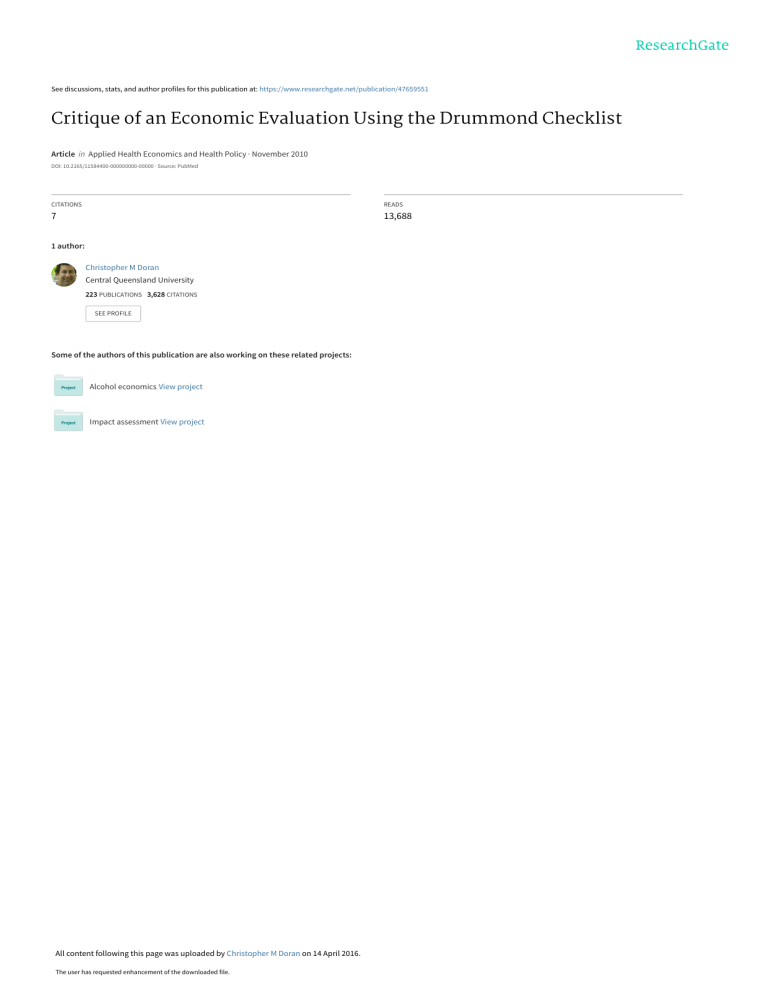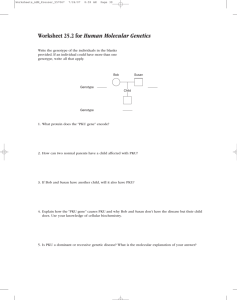
See discussions, stats, and author profiles for this publication at: https://www.researchgate.net/publication/47659551 Critique of an Economic Evaluation Using the Drummond Checklist Article in Applied Health Economics and Health Policy · November 2010 DOI: 10.2165/11584400-000000000-00000 · Source: PubMed CITATIONS READS 7 13,688 1 author: Christopher M Doran Central Queensland University 223 PUBLICATIONS 3,628 CITATIONS SEE PROFILE Some of the authors of this publication are also working on these related projects: Alcohol economics View project Impact assessment View project All content following this page was uploaded by Christopher M Doran on 14 April 2016. The user has requested enhancement of the downloaded file. This material is the copyright of the original publisher. Unauthorised copying and distribution is prohibited. Terms and Conditions for Use of PDF The provision of PDFs for authors' personal use is subject to the following Terms & Conditions: The PDF provided is protected by copyright. All rights not specifically granted in these Terms & Conditions are expressly reserved. Printing and storage is for scholarly research and educational and personal use. Any copyright or other notices or disclaimers must not be removed, obscured or modified. The PDF may not be posted on an open-access website (including personal and university sites). The PDF may be used as follows: • to make copies of the article for your own personal use, including for your own classroom teaching use (this includes posting on a closed website for exclusive use by course students); • to make copies and distribute copies (including through e-mail) of the article to research colleagues, for the personal use by such colleagues (but not commercially or systematically, e.g. via an e-mail list or list serve); • to present the article at a meeting or conference and to distribute copies of such paper or article to the delegates attending the meeting; • to include the article in full or in part in a thesis or dissertation (provided that this is not to be published commercially). EDITORIAL Appl Health Econ Health Policy 2010; 8 (6): 357-359 1175-5652/10/0006-0357/$49.95/0 ª 2010 Adis Data Information BV. All rights reserved. Critique of an Economic Evaluation Using the Drummond Checklist Christopher M. Doran This material is the copyright of the original publisher. Unauthorised copying and distribution is prohibited. National Drug and Alcohol Research Centre, University of New South Wales, Sydney, New South Wales, Australia In this issue of Applied Health Economics and Health Policy, Sladkevicius et al.[1] report the results of an economic evaluation of establishing a neonatal screening programme for phenylketonuria (PKU) in Libya. The authors undertook a cost-effectiveness analysis (CEA) and a return on investment analysis. Against a background of limited resources and rational decision making, economic evaluations have been used more frequently over the past 2 decades as pressures to control healthcare spending have increased.[2] The central purpose of an economic evaluation is to compare the relative value of different interventions in creating better health, longer life or a return on investment.[3] The results of such evaluations are typically summarized as a ratio, where the denominator reflects the gain in health from an intervention (measured as units natural to the programme at hand, such as life-years gained, for a CEA or converted to monetary terms for a costbenefit analysis [CBA]), and the numerator reflects the cost of obtaining that health gain. A variant of CEA, cost-utility analysis (CUA) measures the gain according to health-state preference scores or utility weights, thus providing an opportunity to measure the quality of life-years gained (or disability-adjusted life-years averted), not just the crude number of years.[3] Given the rise in popularity of the use of economic evaluations, guidelines have been developed to improve the methodological rigour, and hence comparability, of each evaluation. Two of the more commonly cited references are the Washington Consensus Panel on Cost-Effectiveness in Health and Medicine[2] and a textbook by Drummond et al.[3] Both provide recommendations for the conduct of economic evaluations in order to improve their quality. Drummond et al.[3] developed a checklist for assessing economic evaluations, which provides useful guidance for those undertaking their own study. It is in the general context of these guidelines that the contribution by Sladkevicius et al.[1] is critiqued. 1. Was a Well Defined Question Posed in Answerable Form? The Libyan healthcare system is faced with resource constraints, with only 3.5% of total GDP being allocated to health. Libya’s population is characterized by large families, high maternal and paternal age and high rates of consanguineous marriages, which are thought to increase the prevalence of disabling and expensive inherited metabolic diseases.[1] With the evident success of neighbouring countries in initiating neonatal screening, primarily for PKU, which can lead to a patient having a healthy life, the Libyan Government is considering a neonatal screening programme for PKU. Against this rationale, the authors’ research question is timely, relevant and clearly stated as an examination of the cost effectiveness of establishing a national neonatal screening programme for PKU in Libya from a societal perspective. 2. Was a Comprehensive Description of the Competing Alternatives Given? The authors provide an excellent overview of the current management of PKU in Libya and Doran 358 model the proposed screening intervention on a protocol produced by the Medical Advisory Panel of the National Society for Phenylketonuria,[4] following adaptation to reflect the Libyan infrastructure. 3. Was the Effectiveness of the Programme Established? was based on protocol-driven requirements and discussions with clinicians and screening equipment suppliers. Few details are reported in the text on the actual quantity of resources utilized, although some reference is made to quantities in the tables. Life-years gained were calculated for both current practice and the proposed intervention using reported life expectancies. Productivity costs were calculated using the human capital approach that combines life-years gained with average annual salary and adjusted for the unemployment rate. The authors also measured transfer payments by taking into account losses in taxation and social security contributions from both patients and carers and disability allowances paid to patients. Although the inclusion of transfer payments is a debatable practice,[2,3] all assumptions used by the authors are clearly outlined. This material is the copyright of the original publisher. Unauthorised copying and distribution is prohibited. The authors based their results on a decision model constructed in Microsoft Excel. The model was populated with data collected from experts, families of patients with PKU and secondary data sources. The primary outcome used in the economic evaluation was the incremental number of life-years gained. The time-horizon of the model comprised the shelf life of the screening equipment and the lifetime of patients with PKU. In a sensitivity analysis, the authors varied, among other things, the potential incidence of PKU and life expectancy of treated PKU patients. 4. Were All the Important and Relevant Costs and Consequences for Each Alternative Identified? Sladkevicius et al.[1] adopted a social perspective, which is the gold standard in economic evaluation. They provide a comprehensive overview of healthcare and social care resources related to screening and treatment of PKU. However, the consideration of non-health resource use was limited to the institutional cost of those PKU patients with mental complications. The outcome of interest for the CEA was life-years gained, while the return on investment analysis was calculated as the ratio of the size of investment to the size of savings over the 15 years of screening and over the lifetime of those diagnosed with PKU. 5. Were Costs and Consequences Measured Accurately in Appropriate Physical Units? An understanding of resource utilization relating to current practice was elicited by interviews with experts and families of PKU patients. Resource use related to the proposed intervention ª 2010 Adis Data Information BV. All rights reserved. 6. Were Costs and Consequences Valued Credibly? A base year of 2007–8 was chosen and all costs are presented in $US. Unit costs of each resource item are presented and varied in the sensitivity analysis. Assumptions underpinning the valuation of outcomes are clear and appropriate. 7. Were Costs and Consequences Adjusted for Differential Timing? Costs incurred in the second and subsequent years were discounted at a rate of 3% per annum. The text makes no mention of discounting transfer payments or indirect costs; however, table V indicates that all costs were discounted. Lifeyears were not discounted in the base case but this assumption was tested in the sensitivity analysis. 8. Was an Incremental Analysis of Costs and Consequences of Alternatives Performed? The authors report both an incremental costeffectiveness ratio of -$US15 500 per life-year gained (cost savings combined with health benefits) and a return on investment of 1 : 1.9, sugAppl Health Econ Health Policy 2010; 8 (6) Editorial gesting that, for every $US1 invested, society would gain $US1.9. 9. Was Allowance Made for Uncertainty in the Estimates of Costs and Consequences? Over the last decade, improvements in computing technology have enabled extensive testing of the sensitivity of cost-effectiveness results to variations in assumptions around the input cost and epidemiological variables. The authors conducted appropriate and rigorous sensitivity and uncertainty analysis; however, they do not present results on a cost-effectiveness plane or an acceptability curve. 359 Second, uncertainty modelling is crucial to examining the robustness of results to variations in parameters, model specification and time horizons. In particular, economic and epidemiological modelling is now used extensively to broaden the time horizon.[5] In summary, economic evaluation is an acceptable and useful tool to assist decision makers in allocating resources across competing healthcare interventions. The rise in popularity of the use of economic evaluations has fostered the development of guidelines to improve the methodological rigour and comparability of evaluations. It is hoped that better adherence to these guidelines will improve the calibre of such appraisals and encourage more effective communication between researchers, clinicians and policy makers. This material is the copyright of the original publisher. Unauthorised copying and distribution is prohibited. 10. Did the Presentation and Discussion of Study Results Include All Issues of Concern to Users? The authors provide a discussion of their findings in the context of study limitations and existing literature. They also address the contentious area of including transfer payments and adopting the human capital approach in valuing lost productivity. The extensive uncertainty analysis lends support to the robustness of results. The key findings are presented and explained in a manner that policy makers can comprehend. The authors also couch the findings in terms of feasibility to policy makers. By considering the Sladkevicius et al.[1] study in the context of guidelines for appraising economic evaluation, the intention has been to provide the reader with an insight into the methodological challenges underpinning such an analysis. Two important aspects are worth reflecting on. First, the perspective adopted for an economic evaluation needs to reflect the purpose of the research. A social perspective is considered the ideal since it aims to capture the full extent of resource use associated with competing healthcare interventions, thus providing a more accurate estimate of the true economic cost to society. ª 2010 Adis Data Information BV. All rights reserved. View publication stats Acknowledgements No sources of funding were used to prepare this editorial. The author has no conflicts of interest that are directly relevant to the content of this editorial. References 1. Sladkevicius E, Pollitt RJ, Mgadmi A, et al. Cost effectiveness of establishing a neonatal screening programme for phenylketonuria in Libya. Appl Health Econ Health Policy 2010; 8 (6): 407-20 2. Gold MR, Siegel JE, Russell LB, et al. Cost-effectiveness in health and medicine. New York: Oxford University Press, 1996 3. Drummond M, O’Brien B, Stoddart G, et al. Methods for the economic evaluation of health care programmes. Oxford: Oxford University Press, 1987 4. The National Society for Phenylketonuria (NSPKU). Management of PKU: a consensus document for the diagnosis and management of children, adolescents and adults with phenylketonuria. London: NSPKU, 2004 [online]. Available from URL: http://www.nspku.org/Documents/Management %20of%20PKU.pdf [Accessed 2009 Jun 17] 5. Liew D, McNeil J, Peeters A, et al. Epidemiological modelling (including economic modelling) and its role in preventive drug therapy. Med J Aust 2002; 177: 364-7 Correspondence: Associate Professor Christopher M. Doran, Health Economist, National Drug and Alcohol Research Centre, University of New South Wales, Sydney, NSW 2052, Australia. E-mail: c.doran@unsw.edu.au Appl Health Econ Health Policy 2010; 8 (6)

